Gallery
- Whitehall (1764), Anne Arundel County
- Maryland State House (1772), Annapolis
- Second St. Anne's Church (designed 1775, completed 1792), Annapolis
Joseph Horatio Anderson | |
|---|---|
| Died | before 1778 |
| Occupation | Architect |
| Buildings | Maryland State House |
Joseph Horatio Anderson was a British-born Colonial American architect active in Annapolis, Province of Maryland, in the late 18th century.
He designed Whitehall (1764), a plantation house in Anne Arundel County, outside Annapolis. He was the likely designer of the third (and current) Maryland State House (1772). [1] [2] He designed the second St. Anne's Church (designed 1775, completed 1792), [1] also in Annapolis, although the church was not completed until more than a decade after his death.
Quite few details are known of Anderson's life. [3]
Though Anderson boasted he was "regularly bread to those Sciences architectural design and construction & the only one upon the Continant[ sic ]," his octagonal design for the dome of the Maryland State House was found to be "contrary to all rules of architecture," and later replaced. [4]
In 1770, Anderson sent a letter to Rhode Island College offering his architectural services to the newly established institution. The correspondence, however, arrived only after construction on the college's new building had already begun. [5]

Annapolis is the capital of the U.S. state of Maryland. It is the county seat of Anne Arundel County and its only incorporated city. Situated on the Chesapeake Bay at the mouth of the Severn River, 25 miles (40 km) south of Baltimore and about 30 miles (50 km) east of Washington, D.C., Annapolis forms part of the Baltimore–Washington metropolitan area. The 2020 census recorded its population as 40,812, an increase of 6.3% since 2010.

Robert Adam was a British neoclassical architect, interior designer and furniture designer. He was the son of William Adam (1689–1748), Scotland's foremost architect of the time, and trained under him. With his older brother John, Robert took on the family business, which included lucrative work for the Board of Ordnance, after William's death.

Sir William Chambers was a Swedish-Scottish architect, based in London. Among his best-known works are Somerset House, and the pagoda at Kew. Chambers was a founder member of the Royal Academy.

The Severn River is a tidal estuary 14 miles (23 km) long, located in Anne Arundel County in the U.S. state of Maryland, south of the Magothy River and north of the South River.
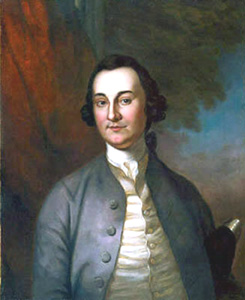
George Plater III was an American planter, lawyer, and statesman from Saint Mary's County, Maryland. He represented Maryland in the Continental Congress from 1778 to 1780, and briefly served as the sixth Governor of Maryland in 1791 and 1792.
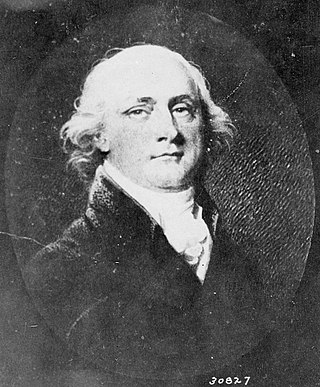
John Francis Mercer was a Founding Father of the United States, politician, lawyer, planter, and slave owner from Virginia and Maryland. An officer during the Revolutionary War, Mercer initially served in the Virginia House of Delegates and then the Maryland State Assembly. As a member of the assembly, he was appointed a delegate from Maryland to the Philadelphia Convention of 1787, where he was a framer of the U.S. Constitution though he left the convention before signing. Mercer was later elected to the U.S. House of Representatives from two different districts in Maryland. In 1801—1803, he served as Maryland's 10th governor.

William Buckland (1734–1774) was a British architect who designed several important buildings in colonial Maryland and Virginia.
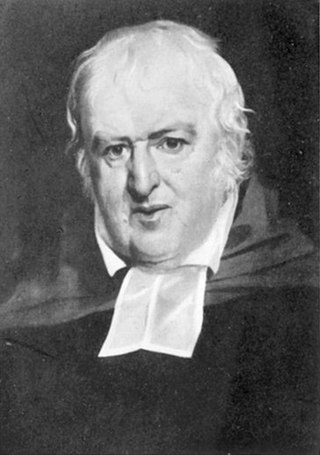
John Andrews was an American Episcopal priest; 4th provost of the University of Pennsylvania (1810–1813), 3rd vice provost (1789–1810), and professor of moral philosophy (1789–1813) of the same college; principal of the Episcopal Academy of Philadelphia (1785–1789); rector of St. Thomas Church in Garrison Forest, Baltimore County, Maryland (1782–1784); founder of the bases of York College of Pennsylvania (1776); minister of St. Peter's Episcopal Church (1767–1770); lecturer; and author of published textbooks and sermons.

The Hammond–Harwood House is a historic house museum at 19 Maryland Avenue in Annapolis, Maryland, USA. Built in 1774, is one of the premier colonial houses remaining in America from the British colonial period (1607–1776). It is the only existing work of colonial academic architecture that was principally designed from a plate in Andrea Palladio's I Quattro Libri dell'Architettura (1570). The house was designed by the architect William Buckland in 1773–1774 for wealthy farmer Matthias Hammond of Anne Arundel County, Maryland. It was modeled on the design of the Villa Pisani in Montagnana, Italy, as depicted in Book II, Chapter XIV of Palladio's work. It was designated a National Historic Landmark in 1960, and is now managed by a non-profit organization as a museum.
John Randall was an architect, American Revolutionary War soldier and officer, and was an early 19th-century mayor of Annapolis, Anne Arundel County, Maryland. He was also the Collector of the Port of Annapolis, which included responsibility for fortifying the harbor.

The William Paca House is an 18th-century Georgian mansion in Annapolis, Maryland, United States. Founding Father William Paca was a signatory of the Declaration of Independence and a three-term Governor of Maryland. The house was built between 1763 and 1765 and its architecture was largely designed by Paca himself. The 2-acre (8,100 m2) walled garden, which includes a two-story summer house, has been restored to its original state.

The Brice House is, along with the Hammond-Harwood House and the William Paca House, one of three similar preserved 18th-century Georgian style brick houses in Annapolis, Maryland. Like the Paca and Hammond-Harwood houses, it is a five-part brick mansion with a large central block and flanking pavilions with connecting hyphens. Of the three, the Brice House's exterior is the most austere, giving its brickwork particular prominence. The Brice House was declared a National Historic Landmark in 1970.

Whitehall is a colonial home that was built beginning in 1764 near Annapolis in Anne Arundel County in the Province of Maryland by Horatio Sharpe, then the provincial governor of the British colony of Maryland.
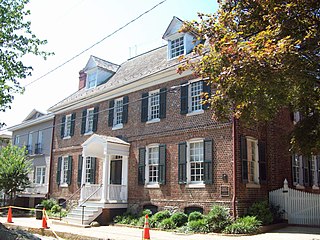
The Peggy Stewart House, also known as the Rutland-Jenifer-Stone House, is a Georgian-style house in Annapolis, Maryland. Built between 1761 and 1764 by Thomas Rutland as a rental property, it was owned at various times by Thomas Stone and U.S. Founding Father Daniel of St. Thomas Jenifer. In October 1774 it was owned by Anthony Stewart, owner of the ship Peggy Stewart. It was listed in the National Register of Historic Places in 1973 for its associations with the burning of Anthony Stewart's ship, Peggy Stewart, as well as for its architectural significance as a mid- to late 18th century Georgian mansion. Furthermore, the dwelling was recognized as a National Historic Landmark for its associations with Jenifer and Stone, and for the thematic representation of politics and diplomacy during the American Revolution
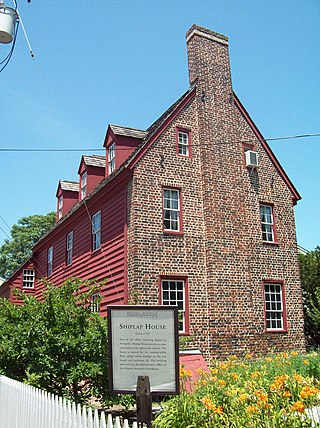
The Colonial Annapolis Historic District is a historic district in the City of Annapolis, the state capital of Maryland, that was designated a National Historic Landmark District in 1965 and was geographically further expanded in 1984.

St. Anne's Episcopal Church is a historic Episcopal church located in Church Circle, Annapolis. The first church in Annapolis, it was founded in 1692 to serve as the parish church for the newly created Middle Neck Parish, one of the original 30 Anglican parishes in the Province of Maryland. It remains in use by the Parish of St. Anne, part of the Episcopal Diocese of Maryland.

Burrages End is a historic home near Lothian, Anne Arundel County, Maryland, United States. It is a small 1+1⁄2-story frame house with gambrel roof. The site is noteworthy for containing a number of buildings from the late 18th century or early 19th century. The house was constructed c. 1780, replacing an earlier house on the site, according to a 1982 study by the Architectural Research Department of the Colonial Williamsburg Foundation, presumably by Col. John Weems who purchased the property in 1764. Weems was the construction contractor for the 1762-65 St. James' Church 3/4 mile to the south. At Weems' death in 1794, Burrages End was sold to Thomas Sellman and remained in that family's hands until 1946. A Weems-Sellman cemetery is on site.
The Broadneck Peninsula is an area in Anne Arundel County, Maryland. The area is north of the Severn River, south of the Magothy River and west of the Chesapeake Bay. At the lower end of the Broadneck Peninsula is the 4.3 mile Chesapeake Bay Bridge.
St. Margaret's is a suburb of Annapolis in Anne Arundel County, Maryland, United States on the scenic Broadneck Peninsula. The ZIP code is 21409.
Thomas Henry Randall was an American architect known for his large country homes during the Gilded Age.